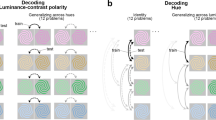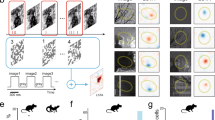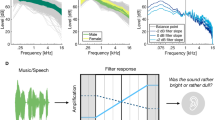Abstract
Brightness—the perception of an object's luminance—arises from complex and poorly understood interactions at several levels of processing1. It is well known that the brightness of an object depends on its spatial context2, which can include perceptual organization3, scene interpretation4, three-dimensional interpretation5, shadows6, and other high-level percepts. Here we present a new class of illusion in which temporal relations with spatially neighbouring objects can modulate a target object's brightness. When compared with a nearby patch of constant luminance, a brief flash appears brighter with increasing onset asynchrony. Simultaneous contrast, retinal effects, masking, apparent motion and attentional effects cannot account for this illusory enhancement of brightness. This temporal context effect indicates that two parallel streams—one adapting and one non-adapting—encode brightness in the visual cortex.
This is a preview of subscription content, access via your institution
Access options
Subscribe to this journal
Receive 51 print issues and online access
$199.00 per year
only $3.90 per issue
Buy this article
- Purchase on Springer Link
- Instant access to full article PDF
Prices may be subject to local taxes which are calculated during checkout


Similar content being viewed by others
References
Gilchrist, A. Lightness, Brightness and Transparency (Lawrence Erlbaum Associates, Hillsdale, New Jersey, 1994)
Eagleman, D. M. Visual illusions and neurobiology. Nature Rev. Neurosci. 2, 920–926 (2001)
Koffka, K. Principles of Gestalt Psychology (Harcourt, Brace, and World, New York, 1935)
Knill, D. C. & Kersten, D. Apparent surface curvature affects lightness perception. Nature 351, 228–230 (1991)
Adelson, E. H. Perceptual organization and the judgment of brightness. Science 262, 2042–2044 (1993)
Gilchrist, A. L. Lightness contrast and failures of constancy: a common explanation. Percept. Psychophys. 43, 415–424 (1988)
Broca, A. & Sulzer, D. La sensation lumineuse en fonction du temps. J. Physiol. Pathol. Gén. 4, 632–640 (1902)
Weichselgartner, E. & Sperling, G. Dynamics of automatic and controlled visual attention. Science 238, 778–780 (1987)
Hahnloser, R. H., Sarpeshkar, R., Mahowald, M. A., Douglas, R. J. & Seung, H. S. Digital selection and analogue amplification coexist in a cortex-inspired silicon circuit. Nature 405, 947–951 (2000)
Rossi, A. F. & Paradiso, M. A. Neural correlates of perceived brightness in the retina, lateral geniculate nucleus, and striate cortex. J. Neurosci. 19, 6145–6156 (1999)
Rossi, A. F., Rittenhouse, C. D. & Paradiso, M. A. The representation of brightness in primary visual cortex. Science 273, 1104–1107 (1996)
MacEvoy, S. P., Kim, W. & Paradiso, M. A. Integration of surface information in primary visual cortex. Nature Neurosci. 1, 616–620 (1998)
Hung, C. P., Ramsden, B. M., Chen, L. M. & Roe, A. W. Building surfaces from borders in Areas 17 and 18 of the cat. Vision Res. 41, 1389–1407 (2001)
Kinoshita, M. & Komatsu, H. Neural representation of the luminance and brightness of a uniform surface in the macaque primary visual cortex. J. Neurophysiol. 86, 2559–2570 (2001)
Bowen, R. W., Pokorny, J. & Smith, V. C. Sawtooth contrast sensitivity: decrements have the edge. Vision Res. 29, 1501–1509 (1989)
Cowey, A. & Rolls, E. T. Human cortical magnification factor and its relation to visual acuity. Exp. Brain Res. 21, 447–454 (1974)
Acknowledgements
We thank A. Holcombe, S. Anstis, X. Huang and M. Fallah for feedback. This research was supported by the Howard Hughes Medical Institute (D.M.E. and T.J.S.) and a grant from the Chapman Foundation and NSF IGERT (J.E.J.).
Author information
Authors and Affiliations
Corresponding authors
Ethics declarations
Competing interests
The authors declare that they have no competing financial interests.
Supplementary information
Supplementary Discussions
1. Suggested model for the Temporal Context Effect. 2. What happens when the two flashes are not simultaneously present (containing Supplementary Figures 1 and 2). (DOC 699 kb)
Rights and permissions
About this article
Cite this article
Eagleman, D., Jacobson, J. & Sejnowski, T. Perceived luminance depends on temporal context. Nature 428, 854–856 (2004). https://doi.org/10.1038/nature02467
Received:
Accepted:
Published:
Issue Date:
DOI: https://doi.org/10.1038/nature02467
This article is cited by
-
Longitudinal evaluation of trifocal and extended depth of focus lenses implantation using standard automated perimetry parameters
International Ophthalmology (2022)
-
Space and time in visual context
Nature Reviews Neuroscience (2007)
-
Characteristics of Human Luminance Discrimination and Modeling a Neural Network Based on the Response Properties of the Visual Cortex
Biological Cybernetics (2006)
-
Image segmentation and lightness perception
Nature (2005)
Comments
By submitting a comment you agree to abide by our Terms and Community Guidelines. If you find something abusive or that does not comply with our terms or guidelines please flag it as inappropriate.



